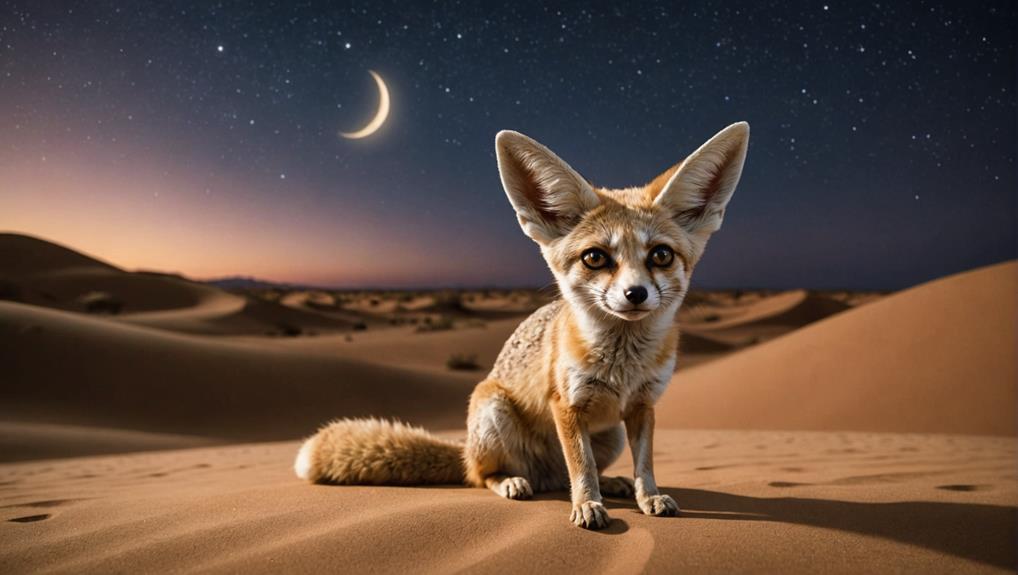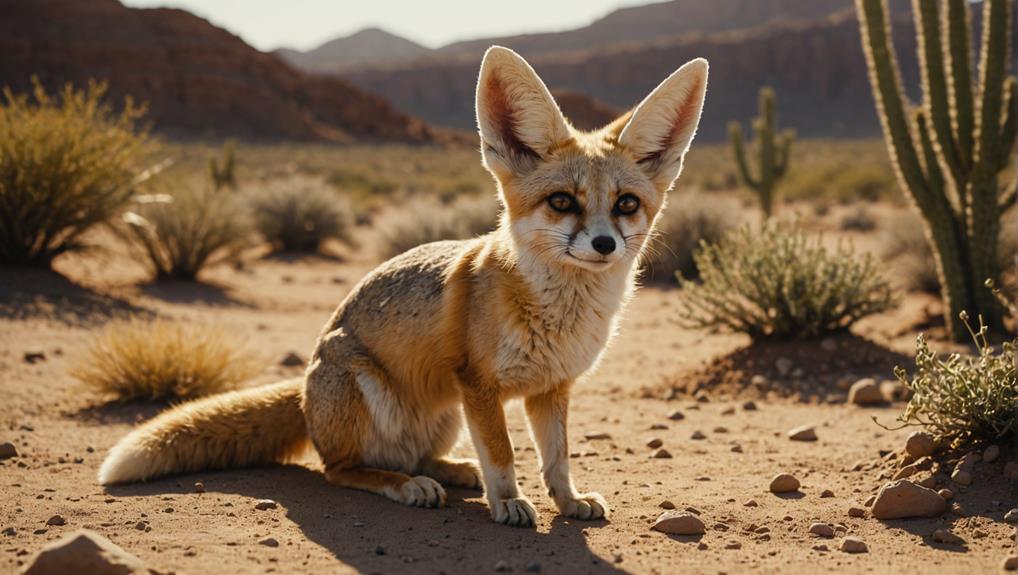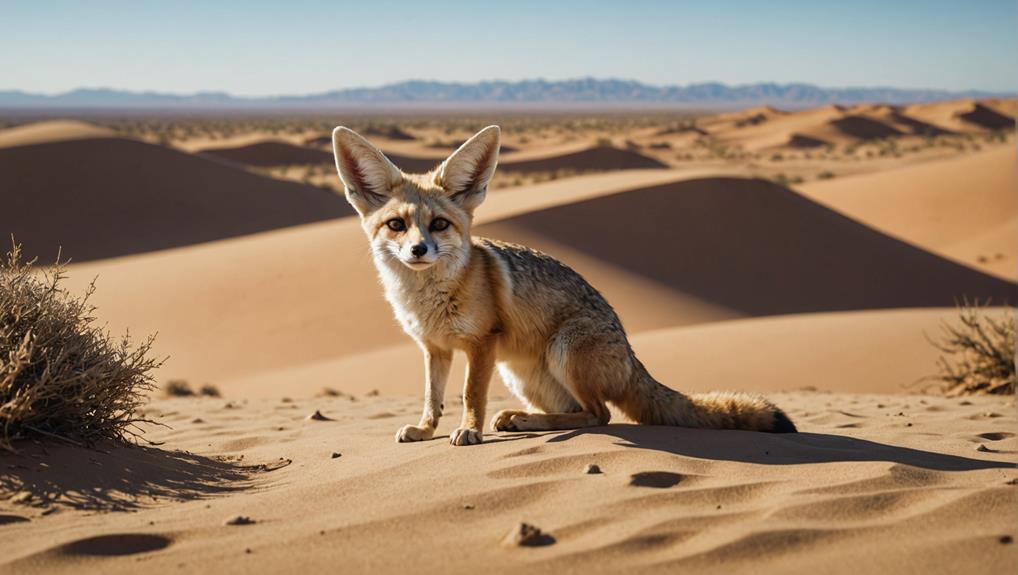Fennec foxes love desert habitats because they've got some amazing tricks up their furry sleeves! Those big ears aren't just for show; they help them hear even the tiniest sounds while keeping cool. Their creamy fur blends right into the sand, making them stealthy little hunters. Plus, they live in burrows to escape the scorching heat, just like a cozy underground hideout. Being nocturnal means they're up at night, catching dinner when it's cool outside. With water-saving smarts, they stay hydrated by munching on their prey. If you're curious about their survival skills and more, there's plenty more to explore!
Contents
Unique Desert Adaptations of the Fennec Fox
The fennec fox is a remarkable survivor in the harsh desert environment, thanks to its unique adaptations. One of its standout features is those large ears, which can grow to half its body size! These ears aren't just for show; they help the fennec fox dissipate heat and enhance its hearing.
Imagine being able to hear a tiny rustle in the sand from far away—that's how they locate their prey in the quiet desert.
Their thick fur-covered paws are another clever adaptation, providing traction on hot sands while protecting them from extreme temperatures. How thoughtful is that? Plus, their cream-colored fur blends perfectly into the sandy surroundings, giving them a stealthy edge against predators.
Fennec foxes are nocturnal, so they come alive at night when it cools down. They're like the night owls of the desert! This lifestyle allows them to avoid the scorching daytime heat while searching for food.
All these adaptations show just how well they're adapted to life in the desert. So, the next time you think about their cute faces, remember the incredible resilience these little creatures have!
The Burrowing Lifestyle: A Key to Survival
Burrowing is a vital part of how fennec foxes thrive in their arid habitat. These clever little creatures dig impressive burrows that can stretch up to 32 feet long! Imagine that! They use these cozy digs to escape the scorching daytime heat and keep safe from predators.
The loose sand in the desert makes it easy for them to excavate, creating complex systems that not only offer protection but also help maintain a stable microclimate.
By burrowing down, fennec foxes cleverly avoid the harsh sun, allowing them to be active during the cooler nights when they hunt and socialize.
Plus, these burrows serve as handy storage spots for food, which they might cache for later. This behavior enhances their chances of survival in such a challenging environment.
Nocturnal Habits for Beating the Heat

Many animals have adapted to survive extreme conditions, and fennec foxes are no exception.
These clever little creatures have become true night owls in the Sahara! By being nocturnal, they dodge the sweltering heat of the day, venturing out when temperatures cool down. They've mastered the art of living under the stars, exploring the desert after dark, making the most of their hunting skills.
When the sun blazes, fennec foxes retreat to their burrows, where they can chill out underground. It's like having a cozy air-conditioned hideaway! Their large ears, which can grow up to 6 inches long, not only help them hear those sneaky insects and small rodents but also radiate body heat. Who knew ears could do that?
This nocturnal lifestyle isn't just a quirky choice; it's vital for their survival. By being active at night, fennec foxes reduce water loss and minimize the risk of overheating.
Water Conservation Strategies
Fennec foxes have an impressive knack for conserving water in their harsh desert environment. You might be surprised to learn that these clever little creatures can go long periods without drinking free water. Instead, they rely on moisture-rich resources found in their prey, like insects and small rodents, which are packed with water. Talk about a smart snack choice!
These foxes also get creative by munching on roots, fruits, and leaves during the dry spells. Their highly efficient metabolism works wonders, allowing them to extract moisture from their food, which minimizes their need for outside water sources. Isn't that amazing?
You'll find that their nocturnal habits play a crucial role in their water conservation strategies. By hunting at night, they avoid the scorching daytime heat, which helps reduce water loss through evaporation.
Plus, they've got a little food storage system going on! When they catch plenty of food, they stash it away in their burrows, ensuring they've access to nutritious, moisture-rich resources when times get tough.
The Fennec Fox and Conservation Efforts

The plight of the fennec fox highlights the urgent need for effective conservation efforts. These adorable little creatures face serious threats, mainly from habitat destruction caused by desertification and human encroachment. As their natural homes shrink, so do their food sources, making it tough for them to survive.
Thankfully, several North African countries, like Morocco and Tunisia, have implemented legal protections to help safeguard fennec fox populations.
But we can't stop there. Conservation efforts must focus on preserving their habitats and raising public awareness about their ecological role. Educating communities about why fennec foxes matter can inspire action and support for their protection.
Plus, the illegal pet trade poses a huge risk, so it's vital to promote responsible consumer behavior and enforce stricter regulations against wildlife trafficking.
One bright spot? Ecotourism! By encouraging local communities to protect fennec fox habitats instead of exploiting them, we create financial incentives that can benefit everyone.
Final Thoughts
In the end, fennec foxes are truly amazing creatures perfectly suited to their desert homes. Their clever adaptations, like digging burrows and staying up at night, help them thrive in such a harsh environment. Plus, their water-saving tricks are nothing short of genius! As we learn about these adorable little foxes, let's remember the importance of protecting their habitats. After all, who wouldn't want to see these fluffy adventurers continue to roam the sands for years to come?














